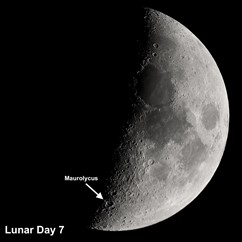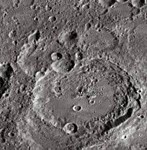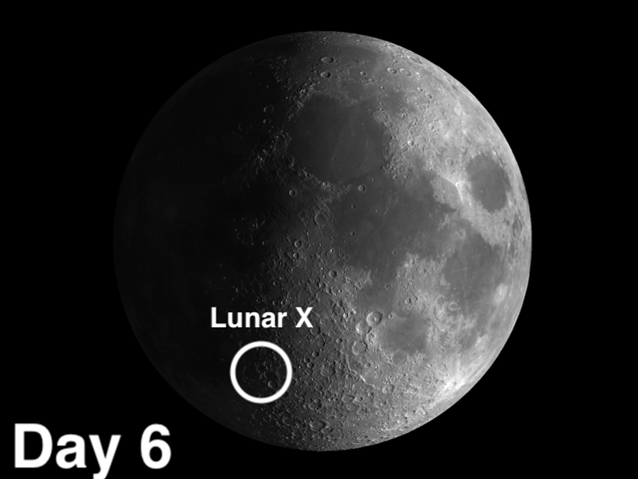The week of May 17-23 takes us from Lunar Day 6 to Day 12. This week we will highlight the crater Maurolycus, viewable on Tuesday evening, Day 7.
 Maurolycus: [SE/P11] Let us venture briefly into a region where angels fear to tread, the lunar Highlands. Plunge in and look for the crater Maurolycus. Although the area looks confusing, Maurolycus will be the largest and most conspicuous crater in this sector. It is a breathtaking sight under an early morning Sun and should not be missed.
Maurolycus: [SE/P11] Let us venture briefly into a region where angels fear to tread, the lunar Highlands. Plunge in and look for the crater Maurolycus. Although the area looks confusing, Maurolycus will be the largest and most conspicuous crater in this sector. It is a breathtaking sight under an early morning Sun and should not be missed.
 Maurolycus displays a rich diversity of different types of features. How many can you see? The central mountain peaks are so tall that they are illuminated long before the Sun finds its way to the dark floor. Also notice how Maurolycus overlaps a smaller, older unnamed crater on its southern border. This flies in the face of the rule that says younger craters are usually smaller than their older brethren.
Maurolycus displays a rich diversity of different types of features. How many can you see? The central mountain peaks are so tall that they are illuminated long before the Sun finds its way to the dark floor. Also notice how Maurolycus overlaps a smaller, older unnamed crater on its southern border. This flies in the face of the rule that says younger craters are usually smaller than their older brethren.
OF ADDITIONAL INTEREST IN SPACE:
 Lunar X: [SE/M10] On Tuesday evening, the Sun will light up the mountain peaks immediately to the west of the crater Blanchinus and you will see a brilliantly lit “X” at the intersection of the rims of Blanchinus, La Caille, and Purbach. Look for it when the terminator is around 2° east, as will be the case on Tuesday evening. Once it has formed, the image will last only for about three hours. The formation is also known as the Purbach Cross and the Werner X. (Because it is not
Lunar X: [SE/M10] On Tuesday evening, the Sun will light up the mountain peaks immediately to the west of the crater Blanchinus and you will see a brilliantly lit “X” at the intersection of the rims of Blanchinus, La Caille, and Purbach. Look for it when the terminator is around 2° east, as will be the case on Tuesday evening. Once it has formed, the image will last only for about three hours. The formation is also known as the Purbach Cross and the Werner X. (Because it is not  an officially recognized object, you will not find it listed on the Field Map. I am indebted to Dana Thompson for permission to use his photo of the Lunar X.)
an officially recognized object, you will not find it listed on the Field Map. I am indebted to Dana Thompson for permission to use his photo of the Lunar X.)
======================
It is highly recommended that you get a copy of Sky and Telescope’s Field Map of the Moon, the very finest Moon map available for use at the telescope. It is available for $10.95 at www.skyandtelescope.com and on Amazon. All features mentioned in this blog will be keyed to the grid on the Field Map and will look like this: Plato: [NW/D9]
Credits:
Courtesy of Gray Photography of Corpus Christi, Texas
Lunar photos: NASA / USGS / BMDO / LROC / ASU / DLR / LOLA / Moon Globe. Used by permission
- Rupes Cauchy: A Best Known Fault on the Moon - July 22, 2024
- Moon Crater Schickard – Crater Floor has Stripes - July 15, 2024
- Moon Craters Langrenus and Vandelinus - July 8, 2024